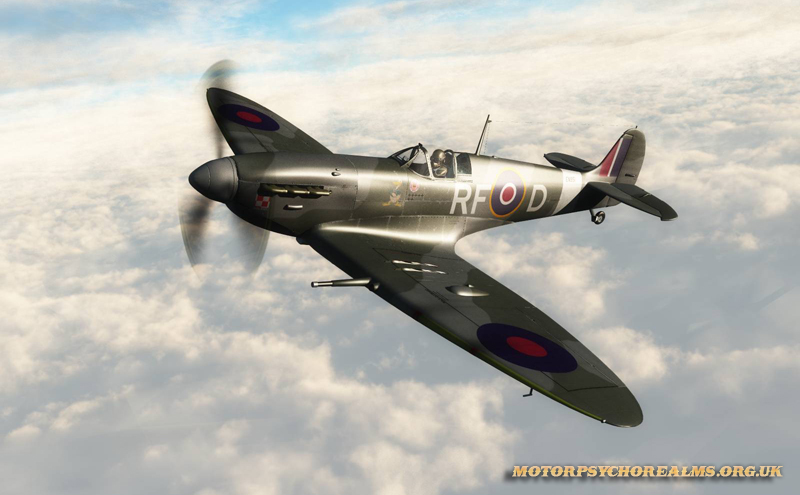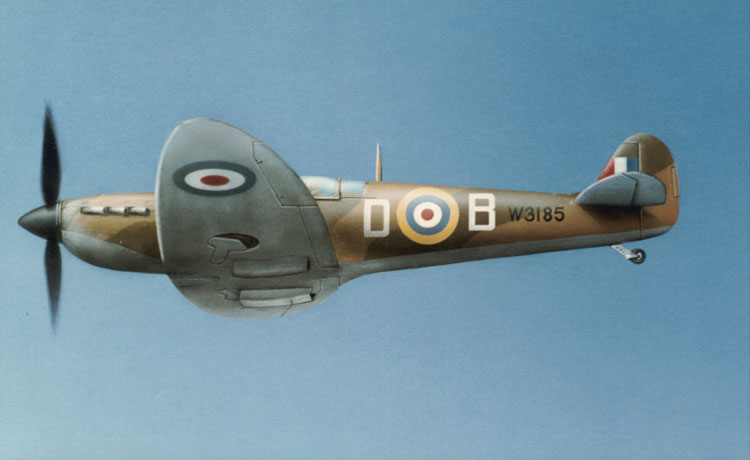Spitfire MkVB

Spitfire MkVB EN951 RF-D; flown by Squadron Leader Jan Zumbach OC No. 303 'Polish' Squadron RAF, October 1942.
This particular aircraft was delivered new to No 133 Squadron in June 1942, then transferred to No 303 Squadron, subsequently it served with Nos 315, 504 and 129 Squadrons and then with the Central Gunnery School eventually finishing the war as as instructional airframe.
This particular aircraft was delivered new to No 133 Squadron in June 1942, then transferred to No 303 Squadron, subsequently it served with Nos 315, 504 and 129 Squadrons and then with the Central Gunnery School eventually finishing the war as as instructional airframe.
Supermarine Spitfire
Origin;- Supermarine Aviation Works Vickers) Ltd., also built by Vickers Armstrongs, Castle Bromwich and Westland Aircraft. (Seafire) Cunliffe Owen Aircraft and Westland.
Type;- Single seat fighter, fighter bomber or reconnaissance. (Seafire) carrier based fighter.
Engine;- One Rolls-Royce Merlin or Griffon vee 12 liquid cooled (see below).
Dimensions;- Span 36'10" (11.23m), clipped 32'2" or, more often 32'7" (9.93m), extended 40'2" (12.24m), length 29'11" (9.12m) later with two stage engine typically 31'4" (9.54m). Griffon engine typically 32'8" (9.96m), final (e.g. Seafire 47) 34'4" (10.46m), height 11'5" (3.48m), with Griffon typically 12'9" (3.89m).
Weights;- Empty (Mk I) 4,810lb (2182kg), (IX) 5,610lb (2545kg), (XIV) 6,700lb (3040kb), (Sea 47) 7,652lb (3458kg)> maximum loaded (I) 5,784lb (2624kg), (IX) 9,500lb (4310kg), (XIV) 10,280lb (4663kg), (Sea 47) 12,750lb (5784kg).
Performance;- Maximum speed (I) 355-366mph (580km/h), (IX) 6,700lb (3040km/h), (XIV) 448mph (721km/h), (Sea 47) 451mph (724km/h), initial climb (I) 2,530ft (770m) /min, (IX) 4,100ft (1250m /min, (XIV) 5,590fy (1396m) /min, (Sea 47) 4,800ft (1463m) /min; range on internal fuel (I) 395 miles (637km), (IX) 434km (700km), (XIV) 460 miles (740km), (Sea 47) 405 miles (652km)>
Armament;- see below.
History;- First flight (prototype) 5 March 1936, (production Mk I) July 1938, final delivery (Mk 24) 24 October 1947.
Users;- (Wartime) Australia, Canada, Czechoslovakia, Egypt, France, Italy (CB), Yugoslavia, Netherlands, Norway, Poland, Portugal, South Africa, Soviet Union, Turkey, UK (RAF, RN), US (AAF).
Development;- Possibly the most famous combat aircraft in history, the Spitfire was designed by the dying Reginald Mitchell to Specification F37/34 using the new Rolls-Royce PV-12 engine, later named Merlin. It was the first all-metal stressed-skin fighter to go into production in Britain.
The following were the main versions:-
I Initial version, 450 ordered in June 1936, with 1,030hp Merlin II, two blade fixed pitch propeller and four 0.303in Browning guns. Later MkIA with eight guns, bulged canopy and three blade DH v-p propeller and MKIB with two 20mm Hispano and four 0.303in Brownings. Production 1,566.
II MK I built at Castle Bromwich with 1,175hp Merlin XII and Rotol propeller. Production 750 MkIIA (eight 0.303in), 170 IIB (two 20mm, four 0.303in).
III Single experimental model strengthened Mk I with many changes.
IV Confusing because MK IV was first Griffon-engined, one built. Then unarmed. Merlin photo-reconnaissance MkIV delivered in quantity. Production 229.
V Like PR.IV powered by 1,440hp Merlin 45, many detail changes. main fighter version 1941-2 in three forms; VA eight 0.303in, VB two 20mm and four 0.303in, VC 'universal' wing with choice of guns plus two 250lb (113kg) bombs. All with centreline rack for 500lb (227kg) bombs or tank. Many with clipped wings and /or tropical filter under nose. Production VA 94, VB 3,923, VC 2,447.
VI High-altitude interim interceptor, 1,415hp Merlin 47, pressurised cockpit, 20mm and four 0.303in. Production 100.
VII High-altitude, extended wing-tips, new 1,660hp Merlin 61 with two-stage supercharges ( and symmetrical underwing radiators ), retractable tail wheel, later broad and pointed rudder. Pressurised cockpit, Production 140.
VIII Followed interim Mk IX, virtually unpressurised Mk VII in LF (low-altitude clipped), F (standard), and HF (high-altitude, extended) versions. Production 1,658.
IX Urgent version to counter Fw 190, quick lash-up of V Merlin 62, again LF, L and HF versions, plus IXE with two 20mm and two 0.5in. Production 5,665.
X Pressurised photo-reconnaissance Merlin 77, whole leading edge forming fuel tank. Production 16.
XI As X but unpressurised, 1,760hp Merlin 63A or 1,665hp Merlin 70. Mainstay of Photo Reconnaissance Unit 1943-45. Production 471.
XII Low altitude to counter Fw 190 hit and run bomber. 1,735hp Griffon III or IV, strengthened VC or VIII airframe clipped. Production 100.
XIII Low-level reconnaissance, low rated 1,620hp Merlin 3, four 0.303in, Production 16.
XIV First with two-stage Griffon, 2,050hp Mk65 with deep symmetric radiators and five blade propeller. Completely redesigned airframe with new fuselage, broad fin/rudder, inboard ailerons, retractable tail wheel, F XIV two 20mm and four 0.303in. F XIVE, two 20mm and two 0.5in. FR XIVE same guns, cut down rear fuselage and teardrop hood, clip wings, F 24 camera and extra fuel, Active in 1944, destroyed over 300 flying bombs. Production 957.
XVI As Mk IX but 1,705hp Packard Merlin 266 LF IXE E-guns and clipped many with teardrop hood, extra fuel. Production 1,054.
XVIII Definitive wartime fighter derived from interim XIV, extra fuel, stronger, F and FR versions, some of latter even more fuel and tropical equipment. Production 300.
XIX Final photo-reconnaissance, 2,050hp Griffon 66 and unpressurised then Griffon 66 with pressure cabin and increased wing-tankage, both option of deep slipper tank for 1,800 miles (2900km) range. Made last RAF Spitfire sortie Malaya 1 April 1954. Production 225.
21 Post-war redesigned aircraft with different structure and shape. 2,050hp Griffon 65 or 85, four 20mm and 1,000lb (454kg) bombs. Production 122.
22 Bubble hood, 24-volt electrics, some with 2,375hp Griffon 65 and contraprop. Production 278.
24 Redesigned tail, short barrel cannon, zero length rocket launchers. Production 54
Total Spitfire production 20,334.
Seafire IB Navalised Spitfire VB, usually 1,415hp low rated Merlin 46. Fixed wing but hook and slinging points. Conversions 166.
HC Catapult spools, strengthened landing gear, 1,645hp Merlin 32 and four blade propeller. Various sub types. Universal wing. Production 262 Supermarine, 110 Westland.
III Manual double-fold wing. 1,585hp Merlin 55M, various versions. Production 870 Westland, 350 Cunliffe-Owen.
XV (Later F15) 1,850hp Griffon VI four blade, asymmetric radiators, cross between Seafire III and Spitfire XII. Production 390.
XVII (F 17) Increased fuel, cut-down fuselage and bubble hood. Production (cut by war's end) 232.
45 New aircraft entirely, corresponding to Spitfire 21, Griffon 61 (five blade) or 85 (contraprop) fixed wing, four 20mm. Production 50.
46 Bubble hood like Spitfire 22. Production 24.
47 Navalised Spitfire 24, hydraulically folding wings, carb-air intake just behind propeller, increased fuel. Fought in Malaya and Korea. Production 140.
Total Seafire production 2,558.
data from Military Aviation Library - World War 2 British Aircraft.

Supermarine Spitfire Mk Va flown by Wing Commander Douglas Bader; crashed in France August 1941. an airbrush painting
Free Tarot Readings by Alison Day
Mystic Realms has linked up with Lotus Tarot, probably the best Tarot Reading site on the internet today.

